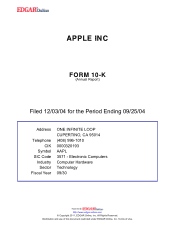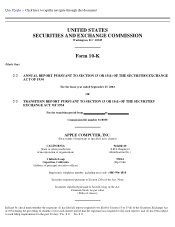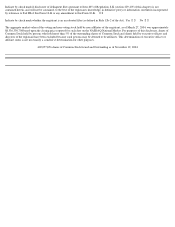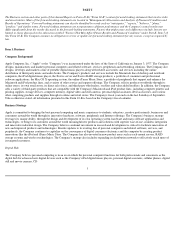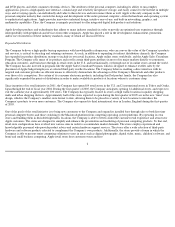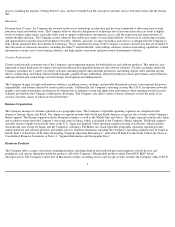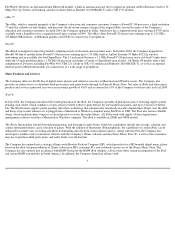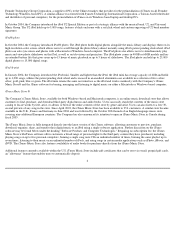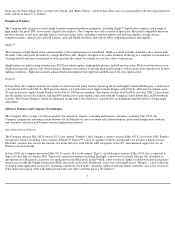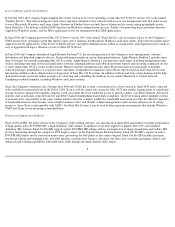Apple 2004 Annual Report Download - page 11
Download and view the complete annual report
Please find page 11 of the 2004 Apple annual report below. You can navigate through the pages in the report by either clicking on the pages listed below, or by using the keyword search tool below to find specific information within the annual report.
Server Software and Server Solutions
In October 2003, the Company began shipping the current version of its server operating system, Mac OS X Server version 10.3 (code-named
"Panther Server"). This release integrates open source and open standards server software with easy-to-use management tools that make it easy
to serve Macintosh, Windows and Linux clients. Features in Panther Server include Server Admin tool for easily setting up multiple servers;
Open Directory 2 for hosting scalable LDAP directory and Kerberos authentication services; Samba 3 for providing login and home directory
support for Windows clients; and the JBoss application server for running powerful J2EE applications.
In June 2004, the Company previewed Mac OS X Server version 10.4 (code-named "Tiger Server"), the next major release of the Company's
UNIX-
based server operating system that deploys open source solutions for Macintosh, Windows and Linux clients. Tiger Server includes native
support for 64-bit applications; iChat Server to deploy private, encrypted communications within an organization; and migration tools to make it
easy to upgrade from legacy Windows servers to Mac OS X Server.
In June 2004, the Company introduced Apple Remote Desktop™ 2, the second generation of the Company's asset management, software
distribution and help desk support software. Along with improvements in screen sharing performance, Apple Remote Desktop 2 includes more
than 50 features for centrally managing Mac OS X systems. Apple Remote Desktop 2 can perform a wide range of desktop management tasks
such as installing operating system and application software, running hardware and software inventory reports and executing commands on one
or more remote Mac OS X systems on the network. Remote software installation tools allow IT professionals to install single or multiple
software packages immediately or at specific dates and times. Comprehensive hardware and software reports based on more than 200 system
information attributes allow administrators to keep track of their Mac OS X systems. In addition, built-in real-time screen sharing enables help
desk professionals to provide online assistance by observing and controlling the desktops of any remote Macintosh or Virtual Network
Computing-enabled computer, including Windows and Linux systems.
Xsan, the Company's enterprise-class Storage Area Network (SAN) file system, was introduced as a beta version in April 2004 and is expected
to be available for general release in the Fall of 2004. Xsan is a 64-bit cluster file system for Mac OS X that enables organizations to consolidate
storage resources and provide multiple computers with concurrent file-level read/write access to shared volumes over Fibre Channel. Advanced
features such as metadata controller failover and Fibre Channel multipathing ensure high availability; file-level locking allows multiple systems
to read and write concurrently to the same volume which is ideal for complex workflows; bandwidth reservation provides for effective ingestion
of bandwidth-intensive data streams, such as high resolution video; and flexible volume management results in more efficient use of storage
resources. Since Xsan is interoperable with ADIC's StorNext File System, it can be used in heterogeneous environments that include Windows,
UNIX and Linux server operating system platforms.
Professional Application Software
Final Cut Pro® HD, the latest version of the Company's video editing software, was introduced in April 2004 and features real-
time performance
of high-quality native DVCPRO HD, a high-definition video format, in addition to real-time support for digital video (DV) and standard
definition (SD) formats. Final Cut Pro HD supports native DVCPRO HD editing with no recompression or image degradation and enables HD
preview monitoring through the computer's DVI display output via the Digital Cinema Desktop feature. Final Cut Pro HD's support of native
DVCPRO HD makes media conversion unnecessary, preserving the full quality of the camera original. Final Cut Pro HD includes precision,
non-modal editing and trimming tools; powerful interface customization features; advanced real-time color correction and image control; and
enhanced audio editing capabilities with multi-track audio mixing and multi-channel audio output.
8

